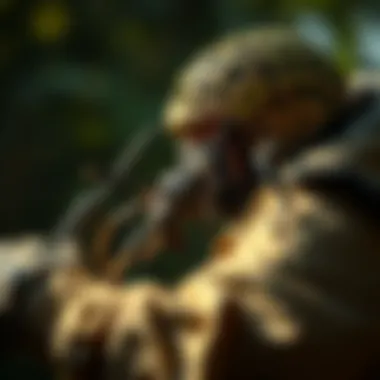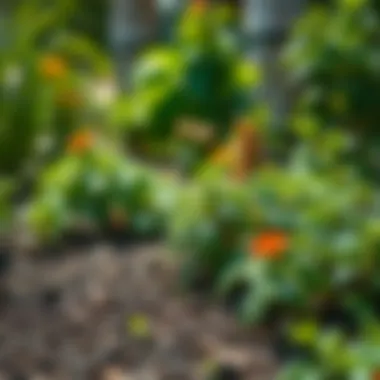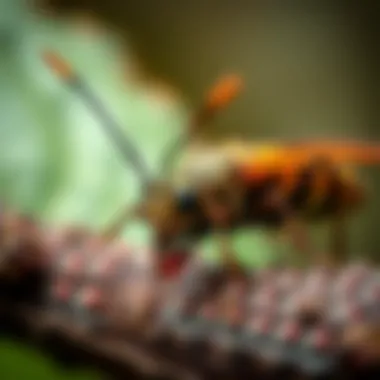Pest Control in Panama City: A Comprehensive Guide


Intro
Pest control in Panama City is not just a matter of maintaining a pretty home; it's about creating a comfortable and safe living environment. Whether you're battling cockroaches that seem to show up uninvited or spiders creeping around your garden, understanding the pests you face is the first step toward effective management.
In this guide, we’ll traverse the intricate landscape of pest control, exploring the myriad of problems homeowners encounter, alongside strategies that are both innovative and environmentally friendly. By delving deeper into pest identification, prevention techniques, and sustainable practices, we aim to arm you with a blend of knowledge and actionable advice that resonates with your lifestyle and concern for the environment.
A critical aspect that's often overlooked is the interplay of pests within our ecosystems. Recognizing their role can lead to better management practices that align with the natural order. So, if you're interested in fostering a pest-savvy household while maintaining the health of your ecosystem, keep reading.
Foreword to Pest Control in Panama City
Pest control in Panama City is not just a matter of convenience; it’s an essential consideration for maintaining the health and wellbeing of inhabitants. This bustling urban area, nestled in the subtropical climate of Florida, becomes a haven for various pests, from invasive insects to unwelcome rodents. Understanding pest control means understanding the underlying factors—like humidity, warm temperatures, and seasonal changes—that can influence pest activity. It's crucial for homeowners to arm themselves with knowledge on how to manage these nuisances effectively, ensuring a safe and comfortable living environment.
Contextual Overview
Panama City presents a unique interplay of ecosystems, thanks largely to its proximity to both urban and coastal settings. The region's climate and geography contribute to an array of pest problems, making it imperative for residents to familiarize themselves with local pest behaviors. For instance, conditions here allow for the rapid reproduction of pests, which can lead to significant infestations if not addressed promptly. Common pests include ants, roaches, and various rodents that may invade homes, seeking shelter and sustenance.
Understanding this context is the first step to effective pest management. It lays the groundwork for identifying species, adopting preventive measures, and – if required – seeking professional help. By recognizing pest patterns and seasonal influences, homeowners can act proactively rather than reactively.
Importance of Integrated Pest Management
Integrated Pest Management (IPM) embodies a holistic approach that emphasizes prevention rather than mere extermination. This strategy is particularly relevant in Panama City, where the diverse pest population requires thoughtful and informed responses. IPM integrates various control tactics—biological, cultural, physical, and chemical—to achieve effective pest management while minimizing risks to people and the environment.
- Environmental Balance: This approach helps maintain the balance within ecosystems. By opting for natural deterrents when possible, one can conserve beneficial insects that play a crucial role in pollination and pest control.
- Cost-Effectiveness: Over time, IPM strategies tend to be more cost-effective than traditional methods, reducing reliance on chemical solutions which can be pricey and hazardous.
- Health and Safety: Implementing IPM reduces exposure to harmful pesticides, promoting a healthier home for families and pets alike. With growing concerns over pesticide safety, many homeowners are looking for sustainable alternatives that do not compromise their health.
- Customization: IPM allows for tailored solutions based on the specific environment and the types of pests encountered. This personalized approach can produce better results than generic treatments.
"Adopting Integrated Pest Management today is a step towards safer, more sustainable pest control tomorrow."
Common Pests in Panama City
Common pests in Panama City pose a significant challenge, not only for homeowners but also for the environment. These pests can lead to property damage, health risks, and even affect the local ecosystem. By understanding the prevalent types of pests, residents can better equip themselves to manage these nuisances effectively. Recognizing the importance of these common pests sets the stage for tailored control measures that are both effective and sustainable.
Insects
Insects play a central role in the pest control narrative within Panama City. Knowing which insects are common in the area helps in devising effective management strategies. Below, we explore three main categories of insects often found in local households and gardens.
Termites
Termites are notorious wood destroyers and can cause substantial structural damage within a short time frame. Known for their ability to consume cellulose, which is found in wood, cotton, and paper, termites attack homes silently, making their presence even more concerning. Their voracious appetite means that the sooner they are detected, the better the chances of limiting damage.
One key characteristic of termites is their social structure; they live in colonies that can range from a few thousand to millions. This makes their presence a common issue in Panama City, particularly in wooden structures. To mitigate the risks posed by these pests, it’s advisable for homeowners to conduct regular inspections and consider professional treatments if signs of infestation are found. Their ability to cause extensive damage quickly makes them a critical inclusion in any pest management discussion.
Ants
Ants are another significant player in the pest landscape. These small insects are often seen foraging for food, making them a common sight in kitchens and pantries. Ant species, such as fire ants and carpenter ants, can cause various problems. Fire ants can deliver painful stings, while carpenter ants, much like termites, can compromise structural integrity.
The adaptability of ants allows them to thrive in diverse environments, so it is crucial to manage food sources and eliminate nest sites to deter them. Their strong social behavior means that, once established, they can be challenging to eradicate, requiring persistent effort. Homeowners often find that natural deterrents, as well as targeted bait, can be effective in controlling ant populations.
Roaches
Roaches, particularly the German and American varieties, are unwanted guests in many homes. These resilient creatures are known for their ability to survive in harsh conditions and reproduce quickly, which can lead to widespread infestations if not managed promptly. They thrive in warmth and moisture, often found in kitchens and bathrooms from Panama City to assorted buildings incliding schools and offices.
The presence of roaches isn’t just a nuisance; they are also carriers of various diseases that can pose health risks to residents. Therefore, keeping areas clean and dry, sealing food containers, and employing traps are vital steps in controlling their population. Their ability to scatter quickly at a mere disturbance often makes them a challenge to manage effectively, but understanding their habits is a step in the right direction.
Rodents
Rodents are perhaps the most recognizable pests in Panama City. Although often underestimated, mice and rats can pose significant threats. Here we’ll delve into these common rodent issues.
Mice
Mice are small, fast, and often go unnoticed until they've established themselves. These creatures can easily invade homes, seeking food and shelter. Their efficient reproduction rate means that populations can grow quickly, leading to the potential for damage to insulation, wires, and even food supplies. One characteristic of mice that sets them apart is their remarkable agility and inquisitiveness. They can squeeze through tiny openings and make their way into attics and basements with ease.
While mice can be seen as harmless due to their small size, their impact can be substantial, prompting many to take aggressive control measures including traps and poisons. Furthermore, they can carry diseases, making it imperative to act swiftly upon their discovery.
Rats
Rats, like the Norway and roof rat, are larger and can be more destructive than their smaller relatives. These rodents are known for their intelligence and adaptability, making them more of a concern for homeowners. They are more aggressive and can cause not just property damage, but also health risks through contamination of food stores.


Their keen sense of smell allows them to locate food sources easily, and they often invade homes in search of solid nourishment. As with mice, effective prevention strategies include sealing entry points, maintaining clean spaces, and employing traps. Their larger size also often means additional damage potential, which necessitates proper management strategies.
Birds and Wildlife
Among the pest issues faced by residents, birds and wildlife can also lead to challenges. Here’s how these pests come into play in daily life.
Squirrels
Squirrels are a common sight in urban and suburban settings, often appreciated for their playful demeanor. However, they can become pests if they invade attics or gardens. One of the notable characteristics of squirrels is their gnawing behavior, which can lead to damages in electrical wires and wood structures. While they don’t carry severe diseases like some other pests, it is essential to address their presence promptly to prevent nesting in unwanted areas.
Their formidable ability to adapt to city life means that homeowners often have to devise ways to keep them at bay, such as securing garbage and using repellents. Their charm can easily fade when they become destructive, underscoring the need for careful management.
Starlings
Starlings, while beautiful birds, can create significant issues when they gather en masse. These birds are notorious for their loud calls and large flocks, which can result in unsightly messes around properties. One unique feature of starlings is their ability to adapt and thrive in urban environments, where they compete well for food sources.
Their presence can often lead to health concerns due to droppings that contribute to disease vectors. Homeowners might find themselves needing to take actions to deter starlings, such as using noise deterrents or bird spikes. Their numbers can grow rapidly, making it vital to implement management strategies promptly to maintain a clean and safe environment.
Identifying Pest Infestations
Recognizing pest infestations timely is crucial for maintaining a healthy and safe living environment. In Panama City, where humidity and warmth create an inviting ecosystem for pests, being adept at identifying these intrusions can save home and property from extensive damage. Ignoring the signs can not only lead to uncomfortable living conditions but may also incur significant financial costs related to pest control and property repairs.
Early detection is a homeowner’s best ally. By noticing subtle signs or behaviors indicative of pest activity, individuals can act before the problem spirals out of control. This section aims to equip homeowners with the knowledge to spot these red flags. From visual cues to behavioral patterns, understanding what to look for is half the battle won.
Visual Signs of Infestation
When it comes to pest infestations, seeing is believing. Here are some telltale signs you might encounter:
- Droppings: Small fecal pellets scattered around are prime evidence. Termites leave behind frass that looks like sawdust, while rodents leave dark, pellet-like droppings.
- Nesting materials: Shredded paper, fabric scraps, or natural debris often serve as a home base for many pests. If you start to see these materials gathering in hidden corners or cabinets, it’s time for a closer inspection.
- Holes or tunnels: Termites and rodents love to gnaw their way into areas that should be off-limits. Look for tiny holes in wooden structures or walls, which can indicate an infestation in progress.
- Visible pests: Sometimes you may spot the pests themselves. If you see ants marching along a clear path or a roach scuttling across the floor, take immediate action.
"Once you spot a single ant, it’s usually a sign that there are many more hiding somewhere nearby."
Noticing these signs promptly can be your golden ticket to preventing costly repairs or health risks.
Behavioral Indicators
Beyond the visual clues, pests exhibit specific behaviors that can alert homeowners to their presence. Understanding these behavioral patterns helps in recognizing an infestation:
- Strange sounds: Listen for unusual noises, especially at night. Scratching or gnawing can hint at rodents making themselves comfortable in your walls or attic.
- Increased activity during certain times: Pests like ants may be more visible during certain hours, particularly when they’re foraging for food. If you notice a sudden influx of ant activity, it’s likely they’ve established a colony nearby.
- Unusual smells: Some pests, especially rodents, emit distinct odors. A rancid or musky smell can be a telltale sign that something is amiss.
- Damaged plants or food: If you notice unusual damage to your garden plants or find food containers inexplicably opened, pests are probably rummaging through your belongings.
In sum, recognizing both visual and behavioral indicators is essential for homeowners in Panama City. By staying vigilant and informed, you can catch pest problems early and take action, ensuring your space remains comfortable and secure.
Effective Prevention Techniques
Preventing pest infestations is just as vital—if not more—than dealing with them post-facto. Creating a robust defense against pests can save homeowners considerable time, expense, and frustration. A prevention-first approach not only protects your living space but also fosters a healthier environment—whether you're raising kids or just enjoying your own peace of mind. This part of the guide will delve into effective strategies to ensure your home remains pest-free.
Home Maintenance Strategies
Conducting regular home maintenance is key to establishing barriers that pests find difficult to penetrate. Here are some practical strategies:
- Sealing Entry Points: Small gaps can be an invitation to unwanted guests. Check windows, doors, and even walls. Use caulking or weather stripping to seal these openings effectively.
- Keeping it Clean: A clean home is less appealing to pests. Regularly vacuum and sweep, paying particular attention to food preparation areas. Get into the habit of wiping down counters daily.
- Proper Food Storage: Store food in airtight containers. Leaving crumbs on counters or improperly stored snacks can encourage ants or roaches to set up shop in your home. Garbage bins should be sealed tightly, and compost should be stored away from the house.
- Moisture Control: Many pests thrive in damp environments. Regularly check for leaks in ceilings, pipes, and basements. Invest in a dehumidifier if necessary to keep humidity levels low.
- Routine Inspections: Develop a routine to inspect your home for signs of pest activity or wear and tear. Early detection can be the difference between a simple fix and a full-blown infestation.
Using these home maintenance strategies not only maintains your property’s value but also prevents potential pest problems before they take off.
Landscaping Practices
The way you manage your outdoor space has a direct impact on pest control. Here are some effective landscaping practices:
- Plant Selection: Choosing the right plants can make a huge difference. Opt for native plants that are more resistant to local pests. Additionally, planting herbs like basil, mint, or rosemary can deter certain insects.
- Mulch Management: Keep mulching to a minimum around your home's foundation. While mulch is great for gardens, it can hide pests and create a damp habitat they love.
- Trim Vegetation: Overgrown trees and shrubs are like highways for pests. Keeping branches and bushes pruned helps prevent pests from finding their way inside.
- Improving Drainage: Ensure your yard has proper drainage to prevent water accumulation. Puddles and standing water are breeding grounds for mosquitoes and other pests. Sloped beds can help with drainage.
- Physical Barriers: Construct physical barriers such as fencing or plant hedges around your garden areas. This can serve as a deterrent to more robust pests like deer or raccoons.
Implementing these landscape strategies not only helps to keep common pests at bay but also contributes to the overall health of your outdoor environment.
Takeaway: By paying attention to both home maintenance and landscaping practices, you lay the foundation for effective pest prevention, creating an environment that's less inviting for pests.
Eco-Friendly Pest Control Solutions
In recent years, the conversation around pest control has shifted considerably. Homeowners in Panama City are now more aware of the environmental implications tied to traditional pest management methods. This awareness has opened the door to eco-friendly pest control solutions—methods that not only tackle pest problems but do so with minimal harm to the surrounding ecosystems. Embracing eco-friendly practices allows homeowners to maintain their properties effectively while fostering a healthier environment for future generations.


Natural Repellents
Natural repellents are a prime component of eco-conscientious pest control. Unlike chemical sprays, these products harness natural ingredients to deter pests without endangering pets or children. Popular options include essential oils like peppermint, eucalyptus, and tea tree oil, which have proven effective against a host of common pests. Application methods vary; some homeowners might use them in sprays, while others opt for diffusers to fill their living space with protective scents.
A notable advantage of natural repellents is their biodegradable nature. They break down without leaving harmful residues, which is certainly a boon for local wildlife and beneficial organisms in the soil. However, homeowners should keep one thing in mind: effectiveness can be variable based on factors such as concentration and the specific pest targeted.
Here's a list of popular natural repellents to consider:
- Peppermint oil: Particularly effective against ants and spiders.
- Cinnamon: This spice not only smells delightful but also repels insects like moths and flies.
- Vinegar: A simple combination of water and vinegar can deter many pests, especially the pesky fruit fly.
To maximize the efficacy of these natural repellents, regular application is essential. Keeping surfaces clean and free from food residues also plays a pivotal role in preventing infestations.
Beneficial Insects
Another innovative approach to pest control in Panama City is the utilization of beneficial insects. While some bugs are notorious for their nuisances, others hold the title of nature’s unsung heroes. For instance, ladybugs are excellent at providing a natural balance by munching on aphids and other harmful insects. Similarly, predatory wasps target pests like caterpillars and beetles, helping to keep gardens healthy.
Forming a supportive ecosystem for these beneficial insects can be as simple as planting specific flora. Flowers such as marigolds and sunflowers attract ladybugs and lacewings, creating a vibrant garden while naturally managing pest populations. Furthermore, preserving habitats through minimal disturbance in the yard is crucial. This allows beneficial insects to thrive and do their work without interference.
Of course, introductions of beneficial insects should be approached thoughtfully. It's essential not to disrupt the ecological balance by introducing non-native species. Instead, enriching the existing habitat with native flora and avoiding pesticides that can harm these beneficial allies is the way to go.
"A key part of living sustainably is recognizing the role every organism plays in our ecosystem."
For more information on biodiversity and the ecological roles of insects, you can explore resources like National Wildlife Federation or visit Entomology Today.
Professional Pest Control Services
When dealing with pest control in Panama City, professional services play a crucial role. Homeowners very often find themselves overwhelmed with the myriad options available to keep unwanted critters at bay. By hiring professionals, you tap into their expertise—something that makes all the difference. They come equipped with specialized knowledge and tools not typically found in a homeowner’s toolkit, making them an essential ally in safeguarding your living spaces.
Choosing a Pest Control Company
Selecting the right pest control company is a decision that shouldn't be taken lightly. Not all companies are created equal, and certain factors can help guide you to the best choice. Here are a few points worth considering:
- Licensing and Certification: Look for companies that are properly licensed and insured. This indicates a level of professionalism and compliance with local laws, an important factor in Panama City.
- Experience: Longevity often translates to success. A company with several years of experience may have faced a variety of pests and can deal with infestations more effectively.
- Reviews and Referrals: Don’t shy away from asking for referrals or checking online reviews. Websites like Reddit and Facebook can offer valuable insights from other homeowners’ experiences.
- Treatment Methods: Ask potential companies about their pest control methods. Are they using eco-friendly techniques? Understanding their approach can help you make a more informed decision.
- Pricing and Estimates: Always get a clear estimate. A reputable company should provide a thorough assessment followed by a detailed quote, without any hidden fees lurking about.
What to Expect from Professional Services
Engaging a pest control service means entering into a partnership aimed at eradicating unwanted guests. Expect a few key components in this process:
- Initial Inspection: Professionals begin with a thorough inspection of your property to identify entry points and the type of pests involved. This is akin to doctors assessing a patient before treatment.
- Custom Treatment Plans: After the initial evaluation, a solid treatment plan will be proposed. This plan often includes both immediate extermination and long-term prevention strategies tailored to your home’s unique structure and pest problem.
- Ongoing Monitoring: A one-time treatment is often not enough. Most responsible companies provide follow-up services to ensure pests don’t stage a comeback. Expect them to set up a regular checkup schedule based on your specific situation.
- Education: Many pest control professionals take the time to educate homeowners about how to minimize future risks. They can impart knowledge on home maintenance and lifestyle changes that deter pests.
- Documentation: You should receive a written report detailing the services performed, materials used, and any additional recommendations. This document serves as a reference for future treatments.
"A pest control service is more than a simple fix; it's a partnership that focuses on creating pest-free environments in the long run."
Choosing to go with professional pest control services is not just about removing pests but about fostering an environment where they have little chance of returning. When you make informed decisions, you pave the way for a pest-free existence tailored to the specific needs of your home in Panama City.
Understanding the Ecological Role of Insects
Insects play an invaluable role in the ecosystem, acting as the unseen gears in the complex machinery of nature. While many think of insects solely as pests, their contributions extend far beyond mere annoyance. They are critical to ensuring the balance of the environment in Panama City and beyond. Understanding their ecological role is essential for effective pest management, as it highlights the need for a nuanced approach when considering pest control strategies.
Pollination and Biodiversity
One of the most significant functions of insects is their role in pollination. Roughly a third of the food we consume relies on the diligent work of pollinators, which primarily include bees, butterflies, and various beetles. In Panama City, this service is crucial, especially for local crops and flowering plants. Without these industrious creatures, many of our fruits, vegetables, and nuts would either be scarce or non-existent.
Moreover, pollination is not just about the food we eat; it enriches biodiversity. Insects contribute to the reproductive processes of numerous plants, ensuring diverse habitats flourish. A city with a vibrant pollinator population enjoys lush parks and gardens, creating a pleasant environment for both humans and wildlife. The interconnectedness of these factors leads to a more resilient ecosystem.
"Insects are not just pests to squish; they are champions of the environment, fostering life in myriad ways."
Decomposition and Soil Health
Insects also play a pivotal role in decomposition, breaking down organic matter and recycling nutrients back into the soil. Consider the common dung beetle, for example; these critters not only remove waste but also aerate and enrich the soil as they burrow. By doing so, they foster healthier plant growth, which in turn supports local wildlife.
A thriving ground of decomposing insects helps form a nutrient-rich environment, essential for gardening and landscaping. This is particularly relevant for homeowners in Panama City who want to maintain vibrant gardens or lush lawns. Healthy soil means healthy plants, leading to beautiful outdoor spaces and improved air quality.
In summary, a comprehensive understanding of the ecological role of insects reveals their necessity in maintaining biodiversity and soil health. This perspective encourages us to reassess our approach to pest management. Sustainable practices need to account for the benefits insects provide while still addressing the challenges they sometimes pose.
Legal and Regulatory Aspects
Understanding the legal and regulatory aspects of pest control is not just about abiding by the law; it plays a crucial role in ensuring effective pest management while protecting public health and the environment. In Panama City, homeowners and professional pest control services alike must navigate a landscape filled with specific guidelines that dictate how pest control measures are to be implemented. These regulations are designed not just for aesthetics but also for the safety and well-being of residents, their pets, and the surrounding ecosystem.


Local Ordinances on Pest Control
Local ordinances are the backbone of pest control regulations. In Panama City, various laws exist to manage pests effectively and with caution. One notable ordinance is the requirement for pest control operators to carry valid licenses. This requirement ensures that individuals classified as pest control professionals have received the proper training to handle chemical treatments and the resources to address infestations effectively.
Moreover, certain species of pests may be protected under state or federal law, meaning that their removal or extermination must follow specific protocols. For example, native birds, such as egrets, cannot be harmed, and any pest control measure must consider their presence. Homeowners should check local guidelines to avoid hefty fines or legal repercussions.
Also, ordinances may dictate the types of chemicals that can be used in residential areas, steering homeowners towards less harmful or more eco-friendly solutions. Here’s a look at some key elements of local ordinances:
- Licensure and Training: Ensure your pest control service is licensed.
- Protected Species: Familiarize yourself with local wildlife regulations.
- Chemical Use: Follow guidelines on allowable pest control substances.
Safety Standards for Pesticides
Pesticides are a double-edged sword; while they can effectively control pests, misuse can pose serious health risks to humans and the environment. The safety standards regarding pesticide application in Panama City are stringent and designed to mitigate these risks. Understanding these standards is essential for homeowners who wish to tackle pest issues responsibly.
Understanding the Environmental Protection Agency’s guidelines can also provide insights into how to work safely with pesticides. The manufacturer’s instructions should always be adhered to, as these guidelines will vary based on the pesticide used. Key safety considerations include:
- Protective Equipment: Always use gloves and masks when applying pesticides.
- Application Timing: Apply pesticides during calm weather to prevent drift.
- Storage Safety: Keep all pesticides out of reach of children and pets.
"Pest control is an art as much as it is a science, ensuring that actions taken do not inadvertently harm the very fabric of the ecosystem."
By staying informed about local ordinances and safety standards, homeowners in Panama City can not only achieve effective pest management but do so in a manner that promotes safety and ecological responsibility. Ignoring these regulations can lead to dangerous outcomes and potential legal issues, but by understanding and complying with them, individuals can create safer and more pleasant living environments.
Future Trends in Pest Management
Pest management continually evolves, adapting to new challenges and discoveries. In Panama City, where the subtropical climate fosters a wide array of pests, keeping abreast of future trends is not just beneficial but essential for effective pest control. Addressing the changing landscape ensures residents can maintain their homes while preserving the delicate balance of the ecosystem.
Technology and Automation
The role of technology in pest management is undeniably significant. Smart devices have begun to transform how we approach pest control tasks. For instance, smart traps that use sensors to identify pest activity can alert homeowners via mobile apps. This advancement means homeowners can tackle infestations before they escalate.
Moreover, automated pest monitoring systems can be implemented in gardens, suburban spaces, and even commercial areas. These systems work around the clock and provide real-time feedback. By analyzing data over time, they help identify patterns that correlate with pest behavior, allowing for more tailored strategies. The reliance on technology streamlines pest control methods, providing more efficient and targeted actions.
Several pest control companies in Panama City are also employing drones for scouting purposes. This technological leap allows for larger areas to be surveyed quickly, spotting potential infestations from above without stepping foot on potentially contaminated ground. In turn, this means safer pest management.
"The future of pest management is not just about killing pests, but understanding them better through technology".
Benefits of Technology and Automation:
- Early Detection: Technologies like smart traps allow for quicker responses.
- Reduced Chemical Use: Automated systems help minimize pesticide application by targeting specific areas.
- Greater Efficiency: Drones and monitoring systems provide a broader perspective for pest control, saving time and resources.
Research and Innovation
The future of pest management is profoundly impacted by ongoing research and innovative practices. Universities and research institutions are continuously studying pest behavior to develop more sustainable methods. One example lies in studying the natural predators of common pests. By understanding how these predators interact with their prey, researchers can promote biological control as an environmentally friendly alternative.
For instance, one of the exciting innovations includes genetically engineered plants that are resistant to specific pests. Scientists are now able to modify plants to withstand attacks, dramatically reducing the need for chemical interventions. These advances not only enhance plant health but also secure food supplies in residential gardens and local farms.
Moreover, studies on pheromone traps demonstrate promising results. Pheromones are chemical signals that pests use to communicate. By luring pests into traps with synthetic versions of these chemicals, effective monitoring occurs without the use of harmful substances. This kind of innovative thinking encourages a more integrated approach to pest management.
Considerations for Future Trends:
- Sustainability Focus: As the world grapples with environmental crises, the push towards less invasive pest management is more crucial than ever.
- Research Investment: Increased funding for pest-related research can lead to breakthroughs that benefit future pest control methods.
- Public Engagement: Educating homeowners about the latest innovations empowers them to participate actively in eco-friendly pest management solutions.
As Panama City continues to grow and develop, keeping pace with these evolving trends in pest management is vital. By harnessing technology and fostering innovation, homeowners can navigate pest control with foresight, ensuring a safer and healthier living environment.
Finale
In wrapping up our comprehensive exploration of pest control in Panama City, it becomes evident that understanding the nuances of pest management is not just beneficial—it's essential for maintaining a comfortable and healthy living environment. The issues related to common pests, advanced prevention techniques, and ecological considerations discussed throughout this guide empower homeowners and gardeners alike. Through a clearer insight into these elements, one can take action that aligns with both immediate needs and long-term sustainability.
Summation of Key Insights
Navigating pest issues in Panama City is about more than just elimination; it's about fostering a harmonious balance between human habitats and nature. Key takeaways from this article include:
- Awareness of Common Pests: Recognizing pests like termites, ants, and rodent species aids in timely interventions.
- Integrated Pest Management: Employing a mix of preventative measures and eco-friendly solutions can mitigate infestations effectively, minimizing harm to the environment.
- Professional Guidance: Engaging with reputable pest control services ensures adherence to safety standards and compliance with local regulations.
- Ecological Contribution: Understanding the role of insects in pollination and soil health highlights that not all insects are adversaries; some are vital for our ecosystem.
These insights serve as crucial building blocks for a home environment that safeguards human health without compromising the ecological integrity of Panama City.
Encouragement for Sustainable Practices
Embracing sustainable pest control practices is not just wise; it’s a responsibility we all share. As we consider methods to tackle pest issues, here are some guidelines to encourage greener approaches:
- Utilize Natural Repellents: Opt for natural substances like diatomaceous earth or essential oils to steer pests clear without synthetic chemicals.
- Promote Biodiversity: Encourage beneficial insects by planting diverse flora. Pollinator-friendly gardens not only beautify landscapes but also help keep pest populations down naturally.
- Integrated Approaches: Combine chemical treatments with non-chemical methods for a balanced strategy. This may involve frequent sanitation, habitat modification, and biological control.
- Stay Informed: Keep abreast of local guidelines and advancements in eco-friendly pest management practices. Resources like EPA.gov and local extension services can provide valuable insights.
Choosing sustainable practices isn't just a trend; it's a meaningful shift towards protecting our environment for future generations. By integrating thoughtful pest management strategies into daily practices, individuals can play a pivotal role in enhancing both personal living spaces and the larger ecosystem in Panama City.



